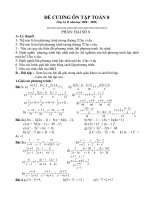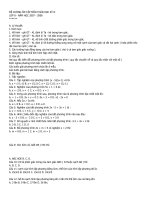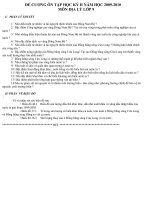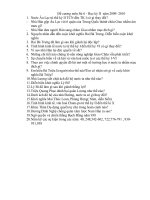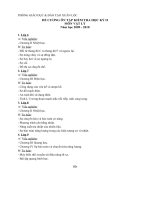ĐỀ CƯƠNG ÔN TẬP ANH 7 HỌC KỲ II
Bạn đang xem bản rút gọn của tài liệu. Xem và tải ngay bản đầy đủ của tài liệu tại đây (121.7 KB, 6 trang )
ĐỀ CƯƠNG ÔN TẬP ANH 7
HỌC KÌ I+II
A. GRAMMAR:
1. Tenses ( Thì)
- Present simple:
* to be:
* ordinary verbs( động từ thường)
* Trạng từ thời gian đi kèm: everyday, every morning, always, usually, often,
sometimes, never
- Present progressive:
*S + is/am/are + V-ing + ...
* Trạng từ thời gian đi kèm: now, at the momen, this morning
- Past simple:
* to be:
* ordinary verbs:
* Adverbs: yesterday, last week, last year...
- Simple Future:
* S+…….
- Near Future: S + is/ am/ are + going to + V(nguyên thể)
Ví dụ:
- I am going see a film at the cinema tonight.(Tôi sẽ đi xem phim tại rạp chiếu phim tối nay.)
- She is going to buy a new car next week. (Cô ấy sẽ mua một chiếc xe mới vào tuần tới.)
- Present perfect
* S+
Trạng từ thời gian đi kèm:
just, recently, lately: gần đây, vừa
mới
for + N – quãng thời gian: trong khoảng (for a year, for a long
time, …)
since + N – mốc/điểm thời gian: từ khi (since 1992, since June,
already: rồi
…)
before: trước đây
yet: chưa (dùng trong câu phủ định và câu hỏi)
ever: đã từng
so far = until now = up to now = up to the present: cho đến bây
never: chưa từng, không bao giờ
giờ
Ví dụ:
– We havemet each other for a long time. (Chúng tôi đã gặp nhau trong một thời
gian dài rồi.)
2. Modal verbs:
must
S+
can/ will
+ ( not) + V -
inf
have to
ought to/ should
3. Question words:
* What, Where, When, Which, Why, How often, How much, How many, How long, How
far
Ex:
How much is it? (Hỏi về giá tiền)
How much + Nkhông đếm được ?
How many + Nđếm được số nhiều ?
2.
hỏi về số lượng
* Hỏi đường:
1. Excuse me, could you tell me how to get to …? xin lỗi, bạn có thể chỉ cho tôi
đường đến … không? ...
Excuse me, do you know where the … is? xin lỗi, bạn có biết … ở đâu không?
Trả lời: _
Take this road
đi đường này
Go down there
đi xuống phía đó
Take the first on the left
rẽ trái ở ngã rẽ đầu tiên
Take the second on the right
rẽ phải ở ngã rẽ thứ hai
* Hỏi khoảng cách
- How far is it from the shoes store to the mini mart?
It’s 500 meters.
Form: How far is/are + S+ from + N + to + N ?
It is + số + meters/kilometers.
4. * So sánh although với in spite of/despite trong tiếng
Anh
Although the traffic was bad, | I arrived on time.
In spite of the bad traffic,| I arrived on time
Despite the bad traffic,| I arrived on time
( Mặc dù giao thông tồi tệ, tôi vẫn đến đúng giờ.)
•
However and nevertheless( Tuy nhiên ) however và nevertheless thường đứng ở đầu
câu khi tương phản hai ý kiến. Tuy nhiên chúng cũng có thể nằm ở giữa hoặc cuối câu.
Trước và sau nó phải có dấu phẩy.
5. Comparative and superlative:
• So sánh hơn
•
So sánh bằng
•
So sánh nhất
(So sánh hơn và so sánh nhất)
Ex: This house is more expensive than that one.
6. Responses with too, either, so and neither:(Câu trả lời tương ứng với too, either, so and
neither)
Ex:
I’d like some peas.
- I’d like, too.
I like spinach.
- So do I.
I don’t like carrots.
- I don’t like, either.
I don’t like durian.
- Neither do I.
* Vị trí và cách sử dụng Neither, either, So , too.
Đầu
Khẳng định
Phủ định
Cuối
So + tobe / modal.V/ TĐT + S
S + tobe / modal V/ TĐT , too
Neither + tobe / modal / TĐT + S
S + toben’t / modaln’t / TĐTn’t , either
7. Indefinite quantifiers: a little, a lot of / lots of, too much
- More: nhiều hơn + Danh từ
- Less: ít hơn + N ko đếm được
- Fewer: ít hơn + N đếm được
Eg: Now, there are more eggs and juice. There is less milk. There is fewer bananas.
8. Why?(Tại sao) -> Because + S + V.
Eg: Why does his tooth hurt?
Because he has a cavity.
9. Câu cảm thán
•
•
WHAT + a/ an + adj + danh từ đếm được. => What a lazy student! ...
HOW + adjective/ adverb + S + V => How lazy a student!
EXERCISES:
I. Choose the best answer:
1. I felf a lot …………..after she fixed my tooth.
A. good
B. better
C. well
D. fine
2. This film is……………than the one we saw last month.
A. as interesting
B. less interesting
C. interesting
D. much interesting
3.. ……………a nice shirt! Did you make it yourself.
A. How
B. What
C. Very
D. Such
C. seeing
D. to see
4. You ought …………….to the dentist
A. to go
B .go
5. ……… Many people in this club, I am not happy now
A. Despite
B. Inspite of
C. Although
D. Because
C. carefuly
D.care
C. safely
D. saferly
6. I know the worker really……………………..
A. careful
B.carefully
7. The river is very……………..for swimmer
A. danger
B. dangerous
8. I ………………stay in bed because I have a bad cold
A. can
B. shouldn’t
C. must
D. ought
9. Nam is absent today. What is the matter…………. him?
A. with
B. for
C. to
D. of
10. How far is it…………………..Hanoi to HCMC ?
A. at
B. in
C. to
D. from
11. Her date of birth is ………………….November 4th.
A. at
B. on
C. in
D. of
C. often
D. much
12. How………………….does the T.V cost ?
A. far
B. long
II. Match the words in column A to ones in column B:
A
B
1.Although I eat very much
a. and I do, too.
2. She always goes to school early
b. are vegetables.
3. Carrots, bananas, cucumbers, tomatoes
c. I can’t be fat more
1………..
2…………
3…………..
III. Identify one mistake in each sentence:
1. We must remembers to eat sensibly.
A
B
C
D
2. What were you buy the souvernir store yesterday.
A B
C
D
3. He is a badly runner. She runs very badly.
A
B
C
D
IV. Pronounciation
1.A. started
B. filled
C. visited
D. needed
2.A. hour
B. house
C. hot
D. heathy
3.A. school
4.A. asked
5. A. usually
B. chemistry
B. stopped
B. unhappy
C. children
D. character
C. called
C. uniform
D. watched
D. useful
V. Choose the word (A, B, C, or D) that best fits each of the blank spaces
Mary came from a rich family and was very pretty. In her family, young girls usually
spend their time going to parties until they married rich young men. But Mary found parties
boring; she wanted to be a nurse. Finally, in 1850, when she was 30, her parents accepted her
decision. So she went to study in a hospital in Germany. Soon she was asked to go to the Japan to
take care of the wounded soldiers. Then she was in charge of a nursing-home for women in
London.
1. When was Mary born?
A. In 1820
B. In 1830
C. In 1850
2. What was Mary like?
A. She likes parties.
B. She likes nurses.
C. She was pretty. D. She was boring.
D. In 1880
3. How did girls in her family spend their free time?
A. They often went to parties.
B. They looked after the patients.
C. They went to study in hospitals.
D. They took care of the sodiers.
4. Did Mary like parties?
A. Yes, she did.
C. She found parties very expensive.
5. What did she do in Crimea?
A. She got married there.
C. She took care of the wounded sodiers.
B. No, she didn`t.
D. She found parties boring.
B. She was in charge of a nursing-home.
D. She became a nurse there.
